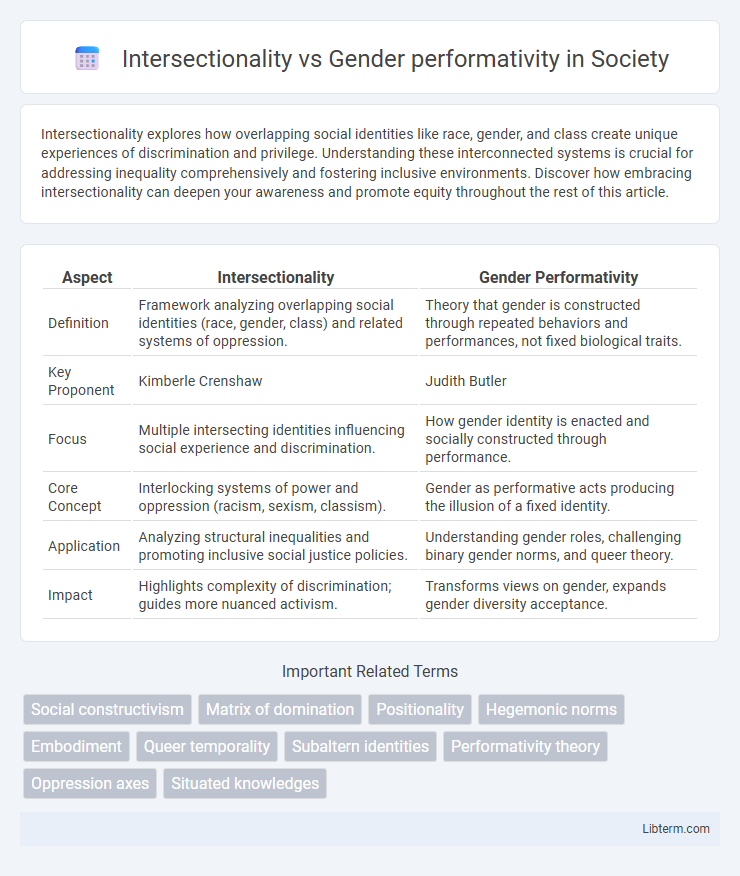Intersectionality explores how overlapping social identities like race, gender, and class create unique experiences of discrimination and privilege. Understanding these interconnected systems is crucial for addressing inequality comprehensively and fostering inclusive environments. Discover how embracing intersectionality can deepen your awareness and promote equity throughout the rest of this article.
Table of Comparison
| Aspect | Intersectionality | Gender Performativity |
|---|---|---|
| Definition | Framework analyzing overlapping social identities (race, gender, class) and related systems of oppression. | Theory that gender is constructed through repeated behaviors and performances, not fixed biological traits. |
| Key Proponent | Kimberle Crenshaw | Judith Butler |
| Focus | Multiple intersecting identities influencing social experience and discrimination. | How gender identity is enacted and socially constructed through performance. |
| Core Concept | Interlocking systems of power and oppression (racism, sexism, classism). | Gender as performative acts producing the illusion of a fixed identity. |
| Application | Analyzing structural inequalities and promoting inclusive social justice policies. | Understanding gender roles, challenging binary gender norms, and queer theory. |
| Impact | Highlights complexity of discrimination; guides more nuanced activism. | Transforms views on gender, expands gender diversity acceptance. |
Understanding Intersectionality: A Framework for Complex Identities
Understanding intersectionality involves recognizing how overlapping social identities--such as race, gender, class, and sexuality--intersect to create unique experiences of oppression and privilege. This framework highlights the complexity of identity beyond singular categories, emphasizing systemic inequalities and power dynamics that shape individual lives. Intersectionality contrasts with gender performativity by focusing on the interconnectedness of various identity factors rather than the repeated enactment of gendered behaviors.
Gender Performativity: The Social Construction of Gender
Gender performativity, a concept rooted in the work of philosopher Judith Butler, frames gender as a continuous act rather than a fixed identity, emphasizing how social behaviors, language, and repeated actions construct and reinforce gender norms. This theory challenges biological determinism by highlighting the fluidity of gender expressions shaped through cultural scripts and power dynamics within society. Understanding gender as a performative social construct reveals how individuals both conform to and resist normative gender roles, influencing policies and discourses around gender equality and identity rights.
Historical Roots of Intersectionality and Gender Performativity
Intersectionality originated from Kimberle Crenshaw's 1989 work, emphasizing overlapping social identities like race, gender, and class, shaping unique experiences of oppression. Gender performativity, introduced by Judith Butler in the 1990s, draws on post-structuralism to argue that gender is an ongoing performance shaped by societal norms rather than a fixed identity. The historical roots of intersectionality lie in Black feminist thought and civil rights activism, whereas gender performativity emerges from queer theory and linguistic philosophy.
Key Thinkers: Kimberlé Crenshaw and Judith Butler
Kimberle Crenshaw introduced the concept of intersectionality to highlight how overlapping social identities, such as race and gender, create unique experiences of oppression and privilege. Judith Butler's theory of gender performativity challenges the notion of fixed gender identities by asserting that gender is constructed through repeated social performances and acts. Both thinkers emphasize the importance of understanding identity as fluid and multifaceted, reshaping feminist discourse and social justice frameworks.
Comparing Core Concepts: Identity, Performance, and Power
Intersectionality emphasizes the interconnected nature of social categorizations such as race, class, and gender, highlighting how overlapping identities produce unique experiences of oppression and privilege. Gender performativity, theorized by Judith Butler, focuses on gender as a repetitive performance shaped by societal norms rather than a fixed identity. Both frameworks analyze power dynamics--intersectionality examines systemic inequalities across interlocking identities, while gender performativity interrogates how power operates through the continuous enactment of gender roles.
Intersections of Oppression: Beyond Gender Alone
Intersectionality examines how overlapping social identities such as race, class, sexuality, and gender create interconnected systems of oppression and discrimination. Gender performativity, a concept developed by Judith Butler, explores how gender identity is constructed through repeated social behaviors rather than being innate. Analyzing intersections of oppression highlights the limitations of focusing solely on gender by revealing how marginalized groups experience compounded inequalities shaped by multiple identity factors.
Critiques and Limitations of Intersectionality and Gender Performativity
Intersectionality faces critiques for its complex framework that can dilute focus by intersecting too many identities, making policy application challenging, while also sometimes overlooking intra-group differences. Gender performativity is criticized for abstracting gender into repetitive acts, potentially minimizing the material and structural constraints faced by individuals. Both frameworks are limited by their theoretical nature, which can hinder straightforward empirical measurement and practical intervention.
Application in Modern Social Movements and Activism
Intersectionality theory, introduced by Kimberle Crenshaw, highlights overlapping social identities and systemic inequalities, while gender performativity, developed by Judith Butler, emphasizes gender as a repeated social performance rather than a fixed identity. Modern social movements utilize intersectionality to address complex layers of oppression affecting marginalized groups, ensuring inclusivity in activism strategies. Gender performativity informs campaigns challenging traditional gender norms, promoting fluidity and diversity in gender expression within contemporary activism.
Intersectionality and Gender Performativity in Media and Culture
Intersectionality examines how overlapping social identities such as race, gender, class, and sexuality create unique experiences of oppression and privilege, especially in media representations that shape cultural narratives. Gender performativity, as theorized by Judith Butler, highlights how repeated behaviors and performances construct gender identity rather than it being an innate quality, influencing how media portrays gender roles and expectations. Media and culture reflect and reinforce these concepts by shaping public understanding of identity through representation, storytelling, and the visibility of diverse experiences.
Integrating Theories: Toward Inclusive Gender Justice
Intersectionality examines how overlapping social identities like race, class, and gender create unique systems of oppression, while gender performativity highlights gender as an enacted and socially constructed behavior. Integrating these theories advances inclusive gender justice by addressing both the structural inequalities and the fluidity of gender expression within marginalized communities. Emphasizing this combined approach fosters policies that recognize diverse experiences and challenge fixed gender norms in pursuit of equity.
Intersectionality Infographic

 libterm.com
libterm.com